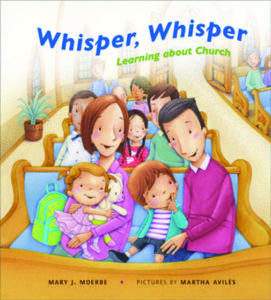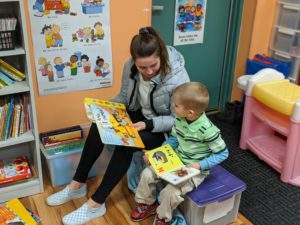 |
Let’s be honest. Worshiping with children does not always feel . . . worshipful. I believe that most parents desperately want to engage their children in worship—but we just don’t know how. Enter the suggestions offered by Phil Huebner and Kelly Huet in this month’s column. They’re worthy of tearing out and posting on the fridge, sharing on your Facebook page, or both! We need to start a new culture of what it means to worship with children, and I believe this month’s authors have ideas that can help us get there. Keep reading.
—Nicole Balza
How do we engage our children in worship?
We’ve all been there. Arms flailing, Cheerios flying, children wailing, while we—the parents—are inwardly dying. It’s tough to raise our children in the church! How do we keep them from making one of those epic scenes that interrupts the worship of others and thoroughly embarrasses us? Or, to put it more succinctly, how do we teach our children to participate and engage in worship?
The first point is to understand that this challenge does not start with the children but with the parents who have been called to raise those children. Then, it’s to understand that parenting should be in partnership with the church, which will assist “in whatever manner possible” to help raise children in the faith (as we pro-mise during the Order of Baptism).
So what do you do? Before you get to the pew, the preparation for worship starts at home—and not just on Sunday morning. Throughout the week, can you have family devotions on the Scripture readings for the coming Sunday and preview the message that will be heard in church? Little eyes and ears may perk up when they hear something familiar! Similarly, try singing the Hymn of the Day for the coming Sunday or a pertinent song for the season. For example, could you sing “Savior of the Nations, Come” regularly during Advent? They’ll be glad to join in to a song they know well!
Or how about those songs of the liturgy that unite the church throughout history and throughout the world? Could bedtime lullabies include the “Gloria in Excelsis,” “Sanctus,” and “Agnus Dei”?
Oh, and speaking of bedtime, the Lord’s Prayer and the Apostles’ Creed are easily learnable for children. These statements of faith will help strengthen and teach the faith as well as prepare your children to participate in worship. Or what about using the Psalm of the Day for the coming Sunday as an evening prayer throughout the week?
Could you preview something about worship as you’re in the car on the way to church? Maybe it’s about the time of year we are in (Advent, Christmas, Lent, etc.). Maybe it’s about the colors we will see in church for a season. Maybe you could share with your children why you’re excited to take Communion on any given Sunday. Give them things to think about and look for in worship.
During the service, help your children learn the way children learn best—modeling their parents and using all their senses. So while you do the “things” of worship, teach them to do the same—to sit and stand, to fold hands and bow the head, to hold a hymnal and follow along, to find something in the Bible, to sing with a joyful heart, to look at the beauty of the sanctuary, and to listen with eagerness to the Word being proclaimed.
Finally, after the service, be sure to do a follow-up of some kind. Perhaps on the way home—or maybe during lunch or later in the day during a devotion—it would be appropriate to debrief and review. Help your children to process what they did in worship earlier in the day.
It won’t always be easy, but what a joy to be the ones to “train up a child in the way he should go” (Proverbs 22:6, English Standard Version).
Phil Huebner
What if we engaged our youth, empowered them, and trained them as leaders for our church and our community? What if worship wasn’t something to endure but a vital part of the week, eagerly anticipated as a place to participate, be encouraged, and find joy in purpose? What if a church’s teens participated in mission trips, led science camp sessions, served on a middle school or high school music team, set up Communion, operated the church’s A/V, served as ushers and greeters, set out coffee and donuts for fellowship, served as children’s Sunday ministry leaders, helped prepare worship folders, and participated in the congregation’s weekly teen ministry?
These are some of the ways our church intentionally engages the students in our congregation. We’ve found that keeping them connected through serving and leading is a core component. In this way, worship is something they participate in and help make possible, not something they are forced to do. If a teen doesn’t show for A/V, no one will be there to run the slides, so their service is critical.
Four years ago, using the above list as a guide, as part of their confirmation we started asking confirmands where they wanted to serve. The first few years were rough, but this year’s confirmation class has a 95 percent participation rate.
The silver bullet isn’t complicated. It’s a culture of worship, being in the Word, and serving together for Jesus. It does take intentional effort by parents and their children, but it is awesome when children see the value of their commitment.
How can you engage your children? It starts with your expectations as a family. Is worship non-negotiable? Or is it something you endure? That time must be so important to your family that nothing is allowed to violate it—not out of fear of God’s punishment or of your pastor thinking less of you but because you revel in that time with God each week.
Sadly, we sometimes become apathetic, discouraged, or jaded with our local church. We lose the sense of awe and wonder, and attending church becomes duty. Slowly we begin griping about church politics, sermon style, and length—and our kids hear it. They wonder why we go if we are just going to complain. Combine that with sports leagues and vacations that take us away from worship, and we should not be shocked when they walk away.
A spirit of participation, encouragement, engagement, and joy for worship can be restored! It starts with confessing that we are part of the problem and asking God for forgiveness and strength to redirect our family toward him. Pause for a moment and read Psalm 103; marvel at God’s wonder and grace.
Finally, after worship, talk about the message on the ride home. What part resonated with you? What questions does it raise for you? How can you apply it throughout the week?
As you and your family focus on and prioritize worship, you’ll begin finding ways to serve together and to allow your teens to see their value within the congregation. Encourage your children to bring a friend along, and before you know it, with prayer and God’s help you too will have a church of youth participating and leading.
Kelly Huet
EXTRA CONTENT
Try this!
 Looking for a way to help your toddler understand the rituals and routines of church? Read Whisper! Whisper! Learning about Church by Mary J. Moerbe. Available from Northwestern Publishing House, 800- 662-6022, nph.net.
Looking for a way to help your toddler understand the rituals and routines of church? Read Whisper! Whisper! Learning about Church by Mary J. Moerbe. Available from Northwestern Publishing House, 800- 662-6022, nph.net.
Author: Multiple authors
Volume 107, Number 02
Issue: February 2020
- Parent conversations: How can parents and kids manage stress?
- Parent conversations: What do your prayers for your children include?
- Parent conversations: How do we resist making our parenting law-based?
- Parent conversations: What Bible passages do you turn to most as a parent?
- Parent conversations: How can we help kids develop positive, healthy habits?
- Parent conversations: What tactics do you use to encourage children to tackle difficult tasks?
- Parent conversations: How can we model good listening skills for our kids?
- Parent conversations: How do we help our kids move on from mistakes?
- Parent conversations: How can we instill gratitude in our children?
- Parent conversations: How can parents find the balance between being too restrictive and too permissive?
- Parent conversations: How can we teach kids to be good friends?
- Parent conversations: What life skills will help young people as they transition to adulthood?
- Parent conversations: How do we discuss death with our children?
- Parent conversations: What does it look like for a father to be a strong Christian leader?
- Parent conversations: How can we help young adults stay engaged in the church?
- Parent conversations: What do parents need to know about video games?
- Parent conversations: How do parents not let worry get the best of them?
- Parent conversations: How do we teach our kids to value all people?
- Parent conversations: When parenting philosophies differ
- Parent conversations: How can we help today’s overwhelmed teens?
- Parent conversations: How can parents maintain a healthy marriage?
- Parent conversations: You might be a Lutheran parent if . . .
- Parent conversations: Parenting post–high school: What is a parent’s role?
- Parent conversations: How can families use the hymnal in their worship life at home?
- Parent conversations: What should Christian parents teach their children about gender?
- Parent conversations: What is vocation? How does it apply to parenting?
- Parent conversations: Why do siblings fight? How should I react when they are fighting?
- Parent conversations: How do we teach children resilience?
- Parent conversations: How do I approach vaccines as a Christian parent?
- Parent conversations: How can I explain the Sixth Commandment to a young child?
- Parent conversations: How can I help my child have an optimistic outlook?
- Parent conversations: What if we can’t follow our Christmas traditions this year?
- Parent conversations: What are ways to foster a rich prayer life in children?
- Parent conversations: How can I let the gospel shine as I parent?
- Parent conversations: How should I handle a child’s separation anxiety?
- Parent conversations: How should families prepare to go back to school?
- Parent conversations: How does a teen’s brain work?
- Parent conversations: How much should I monitor my child online?
- Parent conversations: How can parents reassure children during an uncertain time?
- Parent conversations: How can I stay calm when my child is out of control?
- Parent conversations: Should I give something up for Lent?
- Parent conversations: How can I keep my child engaged in attending church?
- Parent conversations: How can we help a stressed-out kid?
- Parent conversations: How can we nurture a proper view of “stuff”?
- Parent conversations: How involved should parents be in a child’s homework?
- Heart to heart: Parent conversations: Are we modeling kindness for our children?
- Heart to heart: Parent conversations: What’s the best parenting advice you’ve received or given?
- Heart to heart: Parent conversations: How should we handle it when people undermine our parenting decisions?
- Parent conversations: How can we prepare children for summer camp?
- Heart to heart: Parent conversations: What’s a parent’s role as a child dates?
- Heart to heart: Parent conversations: How do parents find contentment?
- Heart to heart: Parent conversations: How can we help a family with a sick parent?
- Heart to heart: Parent conversations: How can parents model healthy cell phone use?
- Parent conversations: How can we protect kids without scaring them?
- Parent conversations: What does your family’s bedtime routine look like?
- Parent conversations: What do I need to consider before I give my child a cell phone?
- Parent conversations: How can we teach gentleness and strength at the same time?
- Parent conversations: What should we do when our children grow silent?
- Parent conversations: What should we teach our children about the Reformation?
- Parent conversations: Do we want our children to be leaders or followers?
- Parent conversations: How does a parent’s role change over time?
- Parent conversations: How should I handle a disagreement with my child’s teacher?
- Parent conversations: What are the building blocks of a strong parent/child relationship?
- Parent conversations: What is our goal as parents?
- Parent conversations: What Christmas traditions do you cherish in your family?
- Parent conversations: How can we raise a generation that cherishes life?
- Parent conversations: What are the best Bible story books for family devotions?
- Parent conversations: Why should children obey their parents?






















